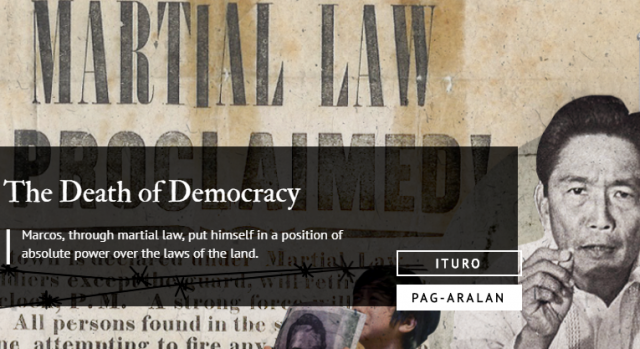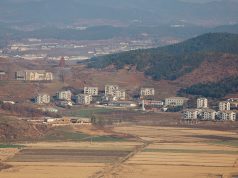MANILA – The burial of former President Ferdinand Marcos at the Libingan ng mga Bayani, the near-victory of then Senator Bongbong Marcos during the vice-presidential elections, and the perceived attempts to revise history have prompted academics at the Ateneo de Manila University to create MartialLawMuseum.ph, which went live on Saturday, five days ahead of the 45th anniversary of the late dictator’s declaration of Martial Law.
Citing more than 300 references, including over 150 books and articles and 100 photos, and about 50 videos, professors and students worked on 25 online exhibits on the strongman’s regime, and lessons that could be learned from it.
For example, said research head Joshua Uyheng, the exhibit titled “Life of an Imeldific Shopaholic” details the former First Lady Imelda Marcos’ shopping sprees.
“She also left behind a bullet-proof bra,” he said, a snippet which caused the audience at Saturday’s launch to burst out laughing.
The academics’ vision: “Never again to a dictatorship that will impose Martial Law, violate human rights, plunder people’s wealth, and bury the truth,” according to project director and Political Science instructor Arjan Aguirre.
They hoped to contribute to the “national memory and engaged citizenship,” he said.
The website features the beginnings of Martial Law, such as Marcos’ eloquent promises and speeches “which made Martial Law palatable to some people.” The events leading up to the declaration, such as the Jabidah Massacre, the First Quarter Storm, and the fake ambush of then Defense Minister Juan Ponce Enrile.
The website also explains how Marcos became a constitutional dictator, manipulating the legal system in order to gain absolute power.
The exhibit “It Takes a Village to Loot a Nation” talks about the networks of corruption that allowed Marcos to perpetuate his power. For example, Antonio Floirendo was given control of the banana industry, recalled Uyheng. The bananas were off-limits to the workers, even if some of the produce – rejects – didn’t meet export standards. Instead, they were reportedly given to cows whose meet was reserved solely for the Marcoses and their cronies.
There is an exhibit specifically for the heroes who fought the dictatorship, and for the road leading to the EDSA People Power Revolution. It continues with the Presidential Commission on Good Government’s hunt for ill-gotten wealth, a discussion of democracy versus authoritarianism, and a primer for engaged citizenship.
But because the creators’ call to action is “mag-aral, magturo, at manindigan (learn, teach, and make a stand),” they have teaching resources like lesson plans and seminars for K-12 educators too.
An example that Math teachers can use in problem-solving goes like this: Thanks to a recent Supreme Court ruling, Some 21 million dollars’ worth of Imelda’s jewels could be auctioned off by government. If a classroom costs P700,000, and a dollar is equivalent to P50, how many classrooms could the money from the stolen jewelry build?
“Teaching history is not limited to Araling Panlipunan,” Uyheng said.
Older students can also play with datasets related to 152 economic indicators of the dictatorship. For example, wages of agricultural workers plunged by 30 percent between the beginning and the end of Marcos rule.

This graph above from the MartialLawMuseum.ph reveals whether Filipinos truly prospered under Marcos rule.
As for “manindigan,” users of the website are urged to spot the signs of a dictatorship, taught how to recognize fake news, and vote for the right leaders.
Ateneo is also holding its first Martial Law Museum Awards, a competition for high school students which asks them, “Paano ko isasapuso ang pambansang kasaysayan natin, at ipaglalaban ang kalayaan, demokrasya, at karapatang pantao (How can I take our history to heart, and fight for freedom, democracy, and human rights)?”
There are art, essay, infographic, poetry, and storytelling categories. Learn more at http://martiallawmuseum.ph/interactive/mlmawards/.
Interdisciplinary Studies professor Rofel Brion stressed that Ateneo de Manila University was not the only unit that was doing its part to preserve history. Ateneo de Naga University would also be erecting a brick-and-mortar Martial Law Museum on its campus.
To this, members of the audience called out, “Davao!”, indicating that Ateneo de Davao University should also launch a similar initiative.
President Rodrigo Duterte, who has declared Martial Law in Mindanao and recently hinted at the possibility of declaring Martial Law nationwide, hails from this city.










